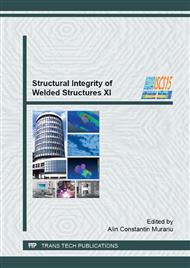p.181
p.187
p.193
p.199
p.205
p.211
p.217
p.223
p.229
Shear Strength Variation for PLmT Welded Zn Coated Advanced High Strength Steels Used in Automotive Structures in Overlap Configuration
Abstract:
The paper presents the results of applying of a new hybrid welding process, i.e. Pulsed LASER-(micro)TIG (PLmT), for realizing overlap joints for Zn-coated U/AHSS thin sheets materials, used in the automotive industry for realizing car structures. The statistical influence onto the joint’s shear strength (objective function) of three hybrid welding process parameters was investigated by means of experimental design and weighted. The influence of laser pulse peak power, the average welding TIG current and the laser pulse duration was investigated for two types of Zn coated U/AHSS used in car body realization. The results revealed that the new process can be applied for the investigated materials and that joints with appropriate shear strength values can be obtained. Each combination did behave rather different in respect to the investigated process parameters and the results did reveal that rather strong interactions are in place between the influence factors (IF) for CPW 800 material. The determined models can be used to select convenient process parameters combinations in respect to minimum Zn coating damage and proper shear strength of the joints for each of the studied materials.
Info:
Periodical:
Pages:
205-210
Citation:
Online since:
July 2015
Authors:
Price:
Сopyright:
© 2015 Trans Tech Publications Ltd. All Rights Reserved
Share:
Citation:


